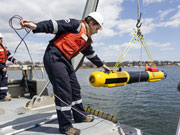Underwater vehicle to be deployed after location identified

 0 Comment(s)
0 Comment(s) Print
Print E-mail CNTV, April 11, 2014
E-mail CNTV, April 11, 2014
US specialists in Massachusetts are also providing support for the search. They are preparing the underwater vehicle, Bluefin-21, which will be deployed in the Indian Ocean once the general location for the missing plane is identified.
"One of the great things about it is that it can work at the extreme operational environment, at the great depths that we're expected to have to survey. And that allows us to put the vehicle down, map the area and return objects of interest." "What it does is it scans using a side scanning sonar. So, it looks to each side of the vehicle, approximately 500 metres a side. And then in that, it is able to return what we call objects of interest." William O'Halloran, director of Marine Operations, Bluefin Robotics, said.
An Australian aircraft detected on Thursday what may be another signal coming from a man-made device deep in the Indian Ocean. It added to hopes that searchers will soon pinpoint the object's location, enabling them to launch the Bluefin-21 submarine to search for the black box from the missing Malaysian jet.
The Australian ship 'Ocean Shield' has also twice picked up sounds consistent with the pings emitted from a plane's flight recorders. The Australian air force has been dropping sonar buoys designed to boost the sound-detectors operating in the search zone, which has been narrowed to an area the size Los Angeles.
The Bluefin-21 submarine moves slowly, and could take six weeks to two months to canvass the current search zone, which is why search teams are still trying to narrow the likely location of the sound.







Go to Forum >>0 Comment(s)